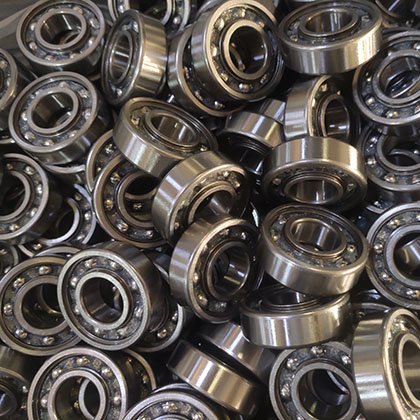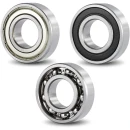
How to check bearing clearance
Checking bearing clearance is an important aspect of Bearing maintenance, especially during installation or when troubleshooting issues such as excessive noise or heat. Here’s how to check bearing clearance:
1. Select the Correct Method: There are several methods to check bearing clearance, depending on the type of bearing and equipment available.
Common methods include:
– Feeler Gauge Method: This method involves using feeler gauges of known thickness to measure the gap between the bearing’s inner race and shaft or outer race and Housing.
– Plastigauge Method: Plastigauge is a thin, soft plastic strip that is placed between the bearing and its mating surface. After assembly, the strip is crushed, and its width is measured to determine the clearance.
– Dial Indicator Method: A dial indicator is used to measure the displacement of the bearing’s outer race relative to its housing or the inner race relative to the shaft. This method provides direct measurement of radial clearance.
2. Understand Bearing Clearance: Bearing clearance refers to the internal gap or space between the rolling elements (balls or rollers) and the inner and outer raceways of the bearing. It is crucial for proper lubrication and to accommodate thermal expansion during operation.
3. Install the Bearing: Install the bearing into its housing or onto the shaft according to the manufacturer’s specifications. Take care not to damage the bearing during installation, as this can affect the accuracy of clearance measurements.
4. Prepare the Bearing and Housing: Ensure that the bearing and its mating surfaces (shaft or housing) are clean and free from debris or contaminants. Proper cleaning is essential to prevent inaccurate measurements and ensure reliable results.
5. Interpret the Results: Compare the measured clearance values to the manufacturer’s recommended specifications or tolerances. If the measured clearance falls outside the acceptable range, it may indicate improper assembly, wear, or other issues requiring further investigation and corrective action.
6. Perform the Measurement: Depending on the chosen method, follow the specific procedure to measure the clearance. Take multiple measurements at different locations around the bearing to ensure accuracy, especially for larger bearings or those with non-uniform clearance.
7. Seek Professional Assistance if Needed: If you are unsure about the measurement process or encounter unexpected results, consider seeking assistance from a qualified technician or bearing specialist. They can provide guidance and expertise to ensure accurate measurement and interpretation of bearing clearance.
8. Document the Findings: Record the measured clearance values and any relevant observations for future reference or maintenance records. Documenting the results helps track the condition of the bearings over time and facilitates timely maintenance interventions when needed.
9. Consider Operating Conditions: Keep in mind that bearing clearance requirements may vary depending on the operating conditions and application-specific factors such as temperature, speed, and load. Consult the manufacturer’s guidelines or engineering resources to determine the appropriate clearance for your specific application.
10. Follow Manufacturer’s Recommendations: Always adhere to the manufacturer’s recommendations and guidelines for bearing installation, maintenance, and clearance measurement. Following best practices and using appropriate tools and techniques will help ensure the reliability and longevity of the bearings in your equipment.
11. Repeat as Necessary: In some cases, it may be necessary to repeat the clearance measurement after adjustments or reassembly to ensure consistency and accuracy. Rechecking the clearance can help confirm proper bearing installation and identify any issues that may have arisen during the initial measurement process.
12. Address Abnormalities Promptly: If you observe significant changes in bearing clearance or encounter abnormal operating conditions such as increased noise, vibration, or temperature, take prompt action to investigate and address the underlying issues. Timely intervention can help prevent further damage to the bearing and associated components.
13. Monitor Clearance Over Time: Bearing clearance can change over time due to factors such as wear, temperature variations, and inadequate lubrication. Regularly monitor bearing clearance during routine maintenance inspections and be alert to any changes or deviations from the expected values.
About us:
As a professional factory that produces professional products, with professional people doing professional things, our foreign customers have declared: “NSAR bearings have reached a domestic first-class and international brand-name quality, and NSAR bearing prices are 30-50% lower than international similar bearings.”
NSAR, a professional 6200 deep groove ball bearings supplier in China, provides a broad variety of 6200 deep groove ball bearing with best customer service and quality assured. With more than 20 years deep groove ball bearings manufacture experience,you can products download, our deep groove ball bearing has been exported to United States, Canada, Mexico, Brazil, Argentina. NSAR can satisfy your bulk deep groove ball bearing customization needs,We provide 6012 bearing and 6000 bearings series and 6301 bearings and pillow block ball bearings and 6300 bearing.
By following these steps and considerations, you can effectively check bearing clearance, maintain optimal performance, and prolong the service life of your bearings. Regular monitoring and proactive maintenance are key to preventing costly downtime and equipment failures associated with bearing issues.




